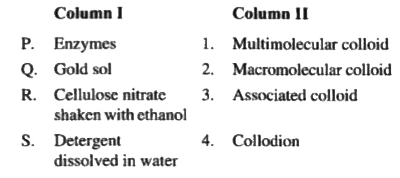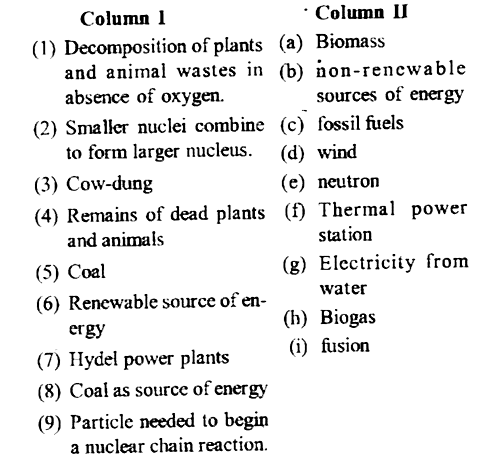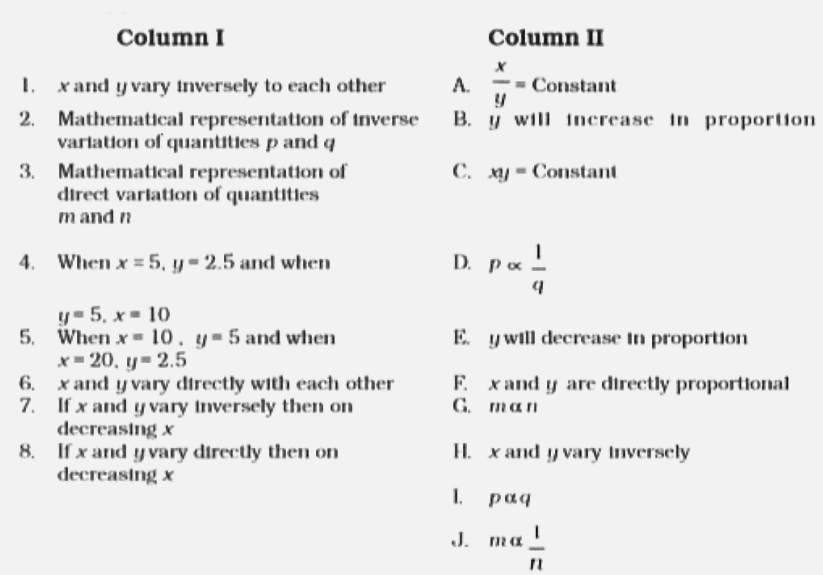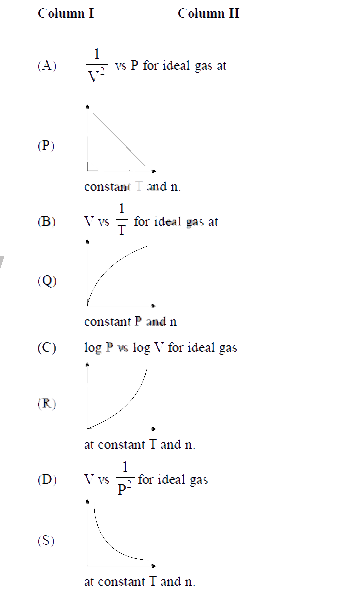Match the entries of column I with appropriate entries of column II and choose the correct option out of the four options given.
Column I (van't Hoff factor)Column II (Behaviour)(A) i>1(p) There is association.(B) i<1(q) There is dissociation.(C) i=1(r) Impossible(D) i=0(s) No association or dissociation
A-p, B-q, C-s, D-r
A-s, B-r, C-p, D-q
A-r, B-s, C-q, D-p
A-q, B-p, C-s, D-r
The correct Answer is:D
To solve the problem of matching the entries from Column I (van't Hoff factor) with the appropriate entries from Column II (Behavior), we need to understand the meaning of the van't Hoff factor (i) and how it relates to the behavior of solutes in solution.
1. Understanding the van't Hoff Factor (i):
- The van't Hoff factor (i) indicates the number of particles a solute breaks into when it dissolves in a solvent.
- For non-electrolytes that do not dissociate, i = 1.
- For electrolytes that dissociate, i can be greater than 1 (for complete dissociation) or less than 1 (for association).
2. Analyzing each case in Column I:
- (A) i > 1: This indicates that the solute dissociates into more particles than it originally was.
- Match with (q): There is dissociation.
- (B) i < 1: This indicates that the solute associates to form fewer particles than it originally was.
- Match with (p): There is association.
- (C) i = 1: This indicates that the solute does not dissociate or associate; it remains as one particle.
- Match with (s): No association or dissociation.
- (D) i = 0: This is an impossible scenario for a solute in solution since it cannot have a van't Hoff factor of zero.
- Match with (r): Impossible.
3. Final Matches:
- (A) i > 1 → (q) There is dissociation.
- (B) i < 1 → (p) There is association.
- (C) i = 1 → (s) No association or dissociation.
- (D) i = 0 → (r) Impossible.
Summary of Matches:
- (A) → (q)
- (B) → (p)
- (C) → (s)
- (D) → (r)
- The van't Hoff factor (i) indicates the number of particles a solute breaks into when it dissolves in a solvent.
- For non-electrolytes that do not dissociate, i = 1.
- For electrolytes that dissociate, i can be greater than 1 (for complete dissociation) or less than 1 (for association).
- (A) i > 1: This indicates that the solute dissociates into more particles than it originally was.
- Match with (q): There is dissociation.
- (B) i < 1: This indicates that the solute associates to form fewer particles than it originally was.
- Match with (p): There is association.
- (C) i = 1: This indicates that the solute does not dissociate or associate; it remains as one particle.
- Match with (s): No association or dissociation.
- (D) i = 0: This is an impossible scenario for a solute in solution since it cannot have a van't Hoff factor of zero.
- Match with (r): Impossible.
- (A) i > 1 → (q) There is dissociation.
- (B) i < 1 → (p) There is association.
- (C) i = 1 → (s) No association or dissociation.
- (D) i = 0 → (r) Impossible.
- (A) → (q)
- (B) → (p)
- (C) → (s)
- (D) → (r)
Topper's Solved these Questions
- SOLUTIONSBOOK - PRADEEPCHAPTER - SOLUTIONSEXERCISE - Competition (FOCUS) JEE (Main and Advanced)/Medical Entrance SPECIAL (V. Matrix-Match Type Questions)
2 Videos
- SOLUTIONSBOOK - PRADEEPCHAPTER - SOLUTIONSEXERCISE - Competition (FOCUS) JEE (Main and Advanced)/Medical Entrance SPECIAL (VI. Integer Type Questions)
10 Videos
- SOLUTIONSBOOK - PRADEEPCHAPTER - SOLUTIONSEXERCISE - Competition (FOCUS) JEE (Main and Advanced)/Medical Entrance SPECIAL (III. Multiple Choice Question )
13 Videos
- REDOX REACTIONS BOOK - PRADEEPCHAPTER - REDOX REACTIONS EXERCISE - Assertion reason type question
16 Videos
- SOME BASIC CONCEPTS OF CHEMISTRYBOOK - PRADEEPCHAPTER - SOME BASIC CONCEPTS OF CHEMISTRYEXERCISE - Competition (FOCUS) JEE (Main and Advanced)/Medical Entrance SPECIAL (VIII. Assertion-Reason Type Questions)(Type II)
13 Videos
Similar Questions
Knowledge Check
Match the entries of Column I with appropriate entries of Column II and select the correct option.
 AP-1, Q-2, R-3, S-4BP-2, Q-3, R-4, S-1CP-2, Q-1, R-4, S-3DP-3, Q-2, R-1, S-4
AP-1, Q-2, R-3, S-4BP-2, Q-3, R-4, S-1CP-2, Q-1, R-4, S-3DP-3, Q-2, R-1, S-4Match the entries in column-I with those of column-II and choose the correct answer.
 AA−(r),B−(s),C−(q),D−(p)BA−(r),B−(q),C−(s),D−(p)CA−(q),B−(r),C−(s),D−(p)DA−(q),B−(s),C−(r),D−(q)
AA−(r),B−(s),C−(q),D−(p)BA−(r),B−(q),C−(s),D−(p)CA−(q),B−(r),C−(s),D−(p)DA−(q),B−(s),C−(r),D−(q)Match the entries in column I with those in column II and choose the correct combination from the options given :
 Aa−4,b−3,c−1,d−2Ba−3,b−4,c−1,d−2Ca−4,b−3,c−2,d−1Da−1,b−2,c−3,d−4
Aa−4,b−3,c−1,d−2Ba−3,b−4,c−1,d−2Ca−4,b−3,c−2,d−1Da−1,b−2,c−3,d−4
Match the entries of Column-I with appropriate entries of Column-II and choose the correct option out of the four option (A), (B), (C) and (D).

View SolutionMatch the entries given in Column I with appropriate ones in Column II

View SolutionMatch each of the entries in Column I with the appropriate entry in Column II

View SolutionMatch the entries in column I with entries in Column II and then pick out correct options.
Column I Column II

View SolutionMatch the entries of column I with appropriate entries of column II and choose the correct option out of the four options given.
Column IColumn IIFor a 5% solution of H2SO4(d=1.01 g mL−1)(A) Molarity of the solution(p) 0.537(B) Molality of the solution(q) 0.0096(C) Mole fraction of H2SO4(r) 0.05(D) Mass fraction of H2SO4(s) 0.515
View Solution


